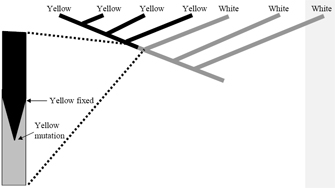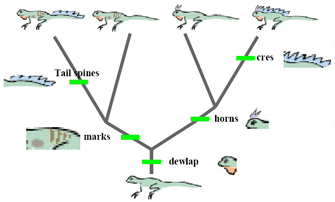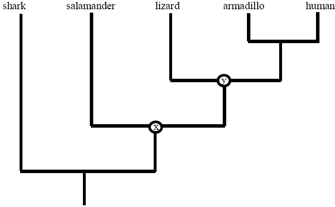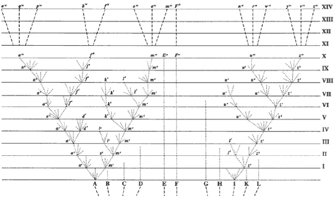« Prev Next »
No matter whether fixation of the derived allele occurs as a result of selection or as a result of genetic drift, this fixation corresponds to extinction of the ancestral allele. Moreover, with the loss of the ancestral allele, the population will have evolved at the phenotypic level—specifically, the population that was formerly fixed for the possession of white flowers will now be made up of only yellow-flowered individuals. Because the time it takes for a mutant allele to arise and become fixed is generally very short compared to the time between successive lineage-splitting events, it is usually safe to ignore the brief period when both the derived and ancestral alleles coexisted in the population, and to instead imagine that the derived trait arose in an evolutionary instant on some internal branch of the phylogenetic tree (Figure 2).
Trait evolution is not predictable. However, once a lineage becomes fixed for a derived trait, descendants of that lineage will all have the derived trait unless there is a subsequent evolutionary change to a new trait (which might even resemble the original ancestral trait). Thus, assuming there is not a subsequent change in flower color, all lineages descended from the original population that was fixed for yellow flowers will also have yellow flowers.
Of course, as phylogenetic trees branch, different lineages accumulate different traits. Figure 3 illustrates this idea using a clade that contains four lizard species. You can see that the differences among these four species are the result of changes that occurred after the group began to diversify. In fact, if you were told which traits evolved on which branches, you could precisely predict which traits each living species would have. Conversely, if given the features of each living species, you could explain the variation between the species by invoking just four events of trait evolution.
As this example illustrates, descendants of an ancestral lineage tend to share common traits, and the presence of these characteristics allows scientists to infer the topology of phylogenetic trees. Although phylogenetic inference is a rich and complex field, it is based on the simple idea that as long as traits (or characters) change their state reasonably rarely (compared to the rate of lineage branching), then the distribution of traits among species provides evidence of how recently these species last shared a common ancestor.
One profound implication of this way of thinking about trait evolution is the idea that living species are the summation of their evolutionary history. In other words, if you list all the traits of a living species, you can assume that each trait arose on an ancestral branch somewhere in that species' history. While some traits, such as the presence of a distinct cellular nucleus, evolved in the ancient past and are shared by many organisms, others, like spoken language, arose much more recently (in this case, very recently, as speech is a uniquely human trait). Thus, understanding the evolutionary history of living species amounts to understanding where on the tree of life these species' distinctive traits arose. Moreover, phylogenetic trees serve as extremely powerful tools for organizing this knowledge of biological diversity.
Phylogenetic Trees and Relatedness
In biology, the concept of relatedness is defined in terms of recency to a common ancestor. As a result, the question "Is species A more closely related to species B or to species C?" can be answered by asking whether species A shares a more recent common ancestor with species B or with species C. To help clarify this logic, think about the relationships within human families. The most recent common ancestors of both you and your siblings are your parents; the most recent common ancestors of you and your first cousins are your grandparents; and the most recent common ancestors of you and your second cousins are your great-grandparents. Note that your parents are situated one generation ago, your grandparents are situated two generations ago, and your great-grandparents are situated three generations ago. This arrangement of ancestors explains why you are more closely related to your siblings than your cousins, and why you are more closely related to your first cousins than your second cousins.
Because evolutionary trees depict common ancestry, they also contain information on the degree of relatedness of the terminal nodes. For example, Figure 4 can be used to determine whether a lizard is more closely related to a salamander or to a human. The first step in answering this question is to trace downward from the appropriate tips of the tree to find the most recent common ancestor of lizards and salamanders (marked x in the diagram). The next step is to use a similar process to locate the most recent common ancestor of lizards and humans (marked y in the diagram). Once you have done this, you can clearly see that node y is a descendant of node x, as indicated by the fact that you must pass through node x to get from the root of the tree to node y. This tells you that lizards are more closely related to humans than they are to salamanders.
Many people are surprised by this conclusion regarding lizards, humans, and salamanders. This conclusion makes sense, however, because there is a lineage (specifically, the internal branch between x and y) that is ancestral to both lizards and humans but not to salamanders. Any trait that evolved on this lineage will therefore tend to occur in lizards and humans but not salamanders. One such trait is the amnion, a protective layer that surrounds the embryo and originally served to allow eggs to mature away from water.
When it comes to this conclusion, one frequent source of confusion is the fact that salamanders and lizards look somewhat alike. However, while it is true that closely related organisms often have similar appearances, this is not always the case. The primary reason for this observation is that morphological evolution can occur at different rates on different branches of a phylogeny. In the example from Figure 4, the similarities of salamanders and lizards (e.g., sprawling gait and lack of fur) are features that trace back to the common ancestor of lizards, salamanders, and mammals. Among the land vertebrates, these are ancestral traits, or plesiomorphies. While the lizard and salamander lineages both retained these ancestral traits, the mammalian lineage underwent dramatic evolutionary divergence, evolving an erect gait, fur, mammary glands, and many other features. These evolutionarily derived features, or apomorphies, are shared by all mammals but are not found in other living vertebrates. Nonetheless, the presence of these uniquely mammalian features does not change the fact that lizards are more closely related to mammals than to salamanders. Remember, relatedness is about descent, not similarity. This should not be surprising. After all, you would still be more closely related to your first cousin than to your second cousin even if you happened to look more similar to the latter!
"Tree Thinking": The Egalitarian View of Diversity
One of the most profound discoveries of evolutionary biology is the fact that all living species are connected through descent from a common ancestor. Thus, there is an underlying unity to life. At the same time, however, there is tremendous diversity in the living world, which is the result of the accumulation of different traits in different organisms. Thankfully, the tree metaphor not only offers a way to keep track of the features of different organisms, but it also provides guidance in how to conceptualize the broad sweep of biological diversity.
Since the time of the ancient Greeks, the prevailing guide to thinking about nature was the so-called "ladder of life," also known as scala naturae. This idea imagines that living species represent various degrees of perfection, with humans as the "most perfect" species and therefore at the top of the ladder (see, for example, Figure 5). Although the ladder of life idea was central to the evolutionary theories advanced by many of his predecessors, Charles Darwin largely rejected the ladder concept in favor of a tree; indeed, the only figure in Darwin's Origin of Species was a tree, reproduced here as Figure 6. Darwin's view of the evolutionary tree is beautifully expressed in the following quote:
The affinities of all the beings of the same class have sometimes been represented by a great tree. I believe this simile largely speaks the truth... The green and budding twigs may represent existing species; and those produced during former years may represent the long succession of extinct species . . . [T]he great Tree of Life . . . covers the earth with ever-branching and beautiful ramifications.(Darwin 131–132)
In the years following Darwin's work, biologists formally rejected the ladder of life in favor of the tree concept. Nonetheless, many current discussions of evolution, especially in the general media, retain vestiges of the ladder view. This is often betrayed by the perception that some organisms are "advanced," whereas others are "primitive." Unfortunately, this ladder-based way of thinking about diversity is not just inefficient, but also positively misleading.
Why is this the case? For one, "ladder thinking" leads to statements that incorrectly imply that one living species or group is ancestral to another; examples of such statements include "tetrapods (land vertebrates) evolved from fish" or "humans evolved from monkeys." But, is the goldfish an ancestor of any living tetrapod? And is the howler monkey really an ancestor of you or any other human? Clearly, the answer to both of these questions is no. Why, then, does a statement like "tetrapods evolved from fish" seem reasonable at first glance?
"Tetrapods evolved from fish" might be intended to imply that the last common ancestor of a fish clade and a tetrapod clade was itself a fish. However, this is not strictly true, because while the last common ancestor of both clades may have had more obvious physical similarities to living fish than to living tetrapods, it was not identical to any living organism (fishlike or otherwise). Both lineages—the one leading to living fish (e.g., goldfish) and the one leading to living tetrapods—have been evolving independently for hundreds of millions of years, and during that time, evolution has not stood still on either the fish or tetrapod branch. Over this period, all aspects of fish physiology and the fish genome have changed, though perhaps in ways that are not obvious to the human eye. Thus, it is not accurate to say that the common ancestor of both fish and tetrapods was a fish. The best you could do would be to say that the common ancestor had a body form and ecology that were more similar to that of living fish than to that of living tetrapods.
Another problem with ladder thinking is that even with such clarifications, it is still easy to make errors of reasoning. For example, suppose you are told that goldfish have body outgrowths (in this case, fins) with cartilaginous structures called rays. You are also told that tetrapods lack rays in their body outgrowths (limbs). If you took a progressive view, you might assume that tetrapods lost their rays during the course of evolution. In reality, however, the common ancestor of both tetrapods and goldfish lacked rays; thus, rays evolved along the lineage that leads to goldfish. In this case, if you had assumed that the ancestor species had rays, ladder thinking would have led you astray. In order to avoid such mistakes, it is best not to make statements such as "tetrapods descended from fish," or at least to do so with the clear understanding that "fish" is referring only to body form and ecology and not to any other features of living fish species.
Tree thinking teaches us that all living organisms are equally distant in time from the root of the tree of life and therefore all are equally advanced. Thus, in the eyes of evolution, a human and a bacterium are equally derived. Although one of these organisms is certainly more morphologically complex than the other, both organisms are remarkable in that they are the product of parents that successfully and repeatedly gave rise to offspring over an unimaginably long time span (at least 3 billion years).
This egalitarian view of life may seem hard to swallow. However, before you reject this idea, consider how the world might look if you were a ladder-thinking bacterium. If that were the case, you would certainly be struck by all the amazing molecular adaptations that your ancestors had accumulated to make you and your kin so successful. You would probably point to a human and note that within its body, there are more bacterial cells than human cells, thereby proving the superiority of bacteria over lumbering eukaryotes. You would likely consider bacteria to be the pinnacle of creation and the rest of the planet's organisms to be evolutionary rejects. On the other hand, if you were a tree-thinking bacterium, your view of life's tapestry would be just like that of the tree-thinking human—in this instance, you would appreciate that all living things are equally amazing products of over 3 billion years of evolution. Thus, tree-thinking not only provides important practical tools for organizing knowledge of biodiversity and for reconstructing evolutionary history, but it also provides a clear and unbiased metaphor for evolution at large.
References and Recommended Reading
Avise, J. C. Evolutionary Pathways in Nature: A Phylogenetic Approach (Cambridge University Press, Cambridge, UK, 2006)
Baum, D. A., DeWitt Smith, S., & Donovan, S. S. The tree thinking challenge. Science 310, 979–980 (2005)
Baum, D. A., & Offner, S. Phylogenies and tree thinking. American Biology Teacher 70, 222–229 (2008)
Darwin, C. On the Origin of Species by Means of Natural Selection, or the Preservation of Favoured Races in the Struggle for Life (John Murray, London, 1859)
Dawkins, R. The Ancestor's Tale: A Pilgrimage to the Dawn of Life (Houghton Mifflin, New York, 2004)
Delsuc, F., et al. Phylogenomics and the reconstruction of the tree of life. Nature Reviews Genetics 6, 361–375 (2005) doi:10.1038/nrg1603 (link to article)
O'Hara, R. J. Homage to Clio: Toward an historical philosophy for evolutionary biology. Systematic Zoology 37, 142–155 (1988)
O'Hara, R. J. Population thinking and tree thinking in systematics. Zoologica Scripta 26, 323–329 (1997)
Maddison, W. P., & Maddison, D. R. MacClade: Analysis of Phylogeny and Character Evolution (Sinauer Associates, Sunderland, MA, 1992)
Tree Thinking Group. Tree Thinking Group homepage, (2004)



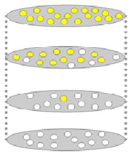
 Figure 1
Figure 1